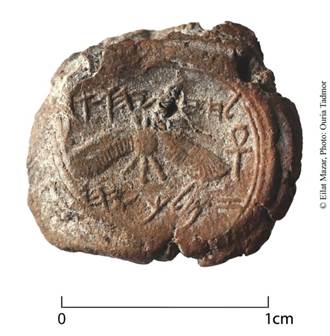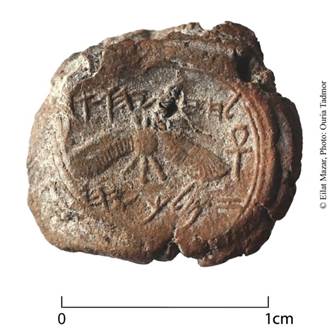The Hebrew University of Jerusalem has announced the discovery of an ancient ‘bulla’ (a clay seal with a personal stamp impressed upon on it) bearing the name of Hezekiah, King of Judah. This is not the first seal bearing Hezekiah’s name to come to light. Nonetheless, it is an exciting find, especially since it was found in situ.
The Discovery
This particular bulla was originally found in 2009 during soil sifting at the excavations on the Ophel ridge to the immediate south of Jerusalem’s Temple Mount. The soil was part of ancient garbage debris that had been dumped between buildings in the northern section of ancient Jerusalem (Iron II). Eilat Mazar, head excavator at the site, interprets a nearby building as a royal storehouse.
Excavators initially misunderstood the writing on the bulla, reading the name as ‘Hezekiah [son of] Malkiah’. It was only recently, after a second check, that the writing on the bulla was deciphered more precisely and the personal name reinterpreted.
The Bulla
Measuring just 13 x 12 mm, the bulla itself is small enough to rest on a fingertip. The writing is, therefore, almost microscopic. An excellent photograph by Ouria Tadmor, however, provides good resolution for analysis.
The front (obverse) is clearly stamped by a personal seal that includes writing and iconography. The rear (reverse) reportedly bears the impressions of two cords that were held in place by the bulla. This suggests the bulla probably sealed a document of some kind. Unfortunately, the document is now lost—presumably a papyrus of some kind, which probably did not survive antiquity.
The Writing
The obverse has two registers, one each on the upper and lower extremities of the seal. The letters are Palaeo-Hebrew, and conform to the epigraphic style we see on a number of seals that can be dated to approximately the early seventh century BC. There is some damage in the upper register, and it is difficult to make out the letters on the far left side of both registers. The words are separated by a small but discernible dot, which is a common practice.
Taking these factors into account, we can offer the following transcription (partially or fully damaged letters are in orange):
לחזקיהו.אח
ז.מלך.יהדה
Belonging to Hezekiah [son of] Ah-
az, King of Judah.
The Hebrew word for ‘son of’ (בן) is omitted. Such an omission was common practice in seals, which were too small to host many letters.
The name is clearly reconstructed to Hezekiah, son of Ahaz. More than this, he is specifically given the title ‘King of Judah’. The word ‘Judah’ appears to be incomplete. The daleth (ד) is only partially visible and the final latter, he (ה), is missing altogether. However, some of Hezekiah’s other seals clearly give the name of the kingdom of Judah in full as יהדה (yehudah). Therefore, we can be confident that the stamp itself did have the fuller spelling of ‘Judah’ on it, but this particular bulla lacks it because of the way the stamp was impressed into the clay.

Drawing of a scarab beetle bulla of Hezekiah. The top line reads יהדה (‘Judah’), and the bottom line reads לחזקיהואחזמלך (‘belonging to Hezekiah [son of] Ahaz, king’).
King Hezekiah
Hezekiah, son of Ahaz, is known from both biblical and Assyrian sources. The exact dates of his reign are debated, but 715–687 BC are the most commonly espoused dates. The Bible tells us that Hezekiah’s father, Ahaz, made the kingdom of Judah a vassal to the Assyrians, against the advice of the prophet Isaiah (Isa 7–8). Ahaz did this in order to procure Assyrian help against an alliance of Damascus and Israel that was threatening him. This set the dominoes toppling that would see both Damascus and Israel fall to the Assyrian armies and be absorbed as provinces into the Assyrian imperial structure. Hezekiah may have been co-regent for a time with his father, Ahaz, but he at least reigned in his own right just after the downfall of the kingdom of Israel in 722 BC.
While Ahaz was content to be an Assyrian vassal, it appears Hezekiah was not. Instead, Assyrian sources tell us he took the political risk of meddling in Philistine affairs. The Bible portrays Hezekiah centralising his power (including the cult of Yahweh) in Jerusalem, thereby extending his sovereignty over his kingdom more directly. This provoked the ire of the Assyrian king, Sennacherib, who invaded Judah in c. 701 BC. Sennacherib claims to have destroyed 46 cities of Judah and deported their survivors. He even depicted the siege of Judah’s second largest city, Lachish, on the walls of his palace. The Bible tells us that Hezekiah tried to bribe Sennacherib with treasure from the temple in Jerusalem, and even appealed to Egypt for military help. However, all this failed. In his annals, Sennacherib claims to have cooped Hezekiah up in Jerusalem like a bird in a cage.
Surprisingly, Sennacherib did not end up taking Jerusalem. The fact that Hezekiah provoked the unrestrained wrath of Assyria, experienced the full-scale barbaric invasion of his country, which brought Judah to the very brink of destruction, only to emerge still on the throne in an unscathed Jerusalem (there is no layer of destruction or evidence of Assyrian siege in the relevant archaeological strata) with the Assyrian armies returning to Mesopotamia is perhaps one of the greatest stories of political survival against the odds in history. It’s no wonder the Bible attributes this to the divine intervention of Yahweh himself and gives Hezekiah a generally glowing report card.
Iconography
In the centre of the bulla is a sun disk. It emits six rays and has a set of wings that curve gently downwards in a posture of protection. The imagery of a winged sun disk is ubiquitous in the ancient Near East. It can be found in Egyptian, Assyrian, Persian, and Ptolemaic iconography. The sun usually is a cipher for the chief deity of the culture to which the owner of the seal belonged. In Assyria and Persia, the disk is often augmented with the depiction of a personal figure—the god Asshur in the case of Assyria, and the god Ahura Mazda in Persian depictions. However, no such personal depiction of a deity is seen in the sun disk here.
There are two options for interpreting the sun disk here.
First, it might be depicting the sun god, showing Egyptian influence. To that end, we note that on the right side of the bulla we see the ankh, the Egyptian symbol for life. The faint vestiges of a second ankh are just visible on the far left side of the bulla also. Hezekiah is known to have appealed to Egypt for military assistance against Sennacherib, though this was unsuccessful. Thus, in his anti-Assyrian stance, Hezekiah may well have absorbed Egyptian influence. Some of his other seals display a scarab beetle, which is clearly influence by Egyptian iconography. Furthermore, we know that in the early sixth century BC—a century after Hezekiah—the sun god was worshipped in the Jerusalem temple, though the practice is condemned in Ezekiel 8.16–18. This particular understanding of the iconography has explanatory power, though it is at odds with the biblical depictions of Hezekiah as an avowed exclusive Yahwist.
The alternative option is to understand the sun disk as a compatible cipher for Yahweh, the national deity of Israel and Judah, and patron deity of the Davidic dynasty in Jerusalem. While it is clear that Hezekiah did adopt Egyptian iconography, this does not necessitate his own worship of Egyptian deities. The compatibility of such iconography with Yahwistic religion is seen in a couple of places in the Bible. For example, Psalm 84.12 [84.11 Heb] says, ‘For sun and shield is Yahweh God; favour and glory does Yahweh give.’ In Malachi 4.2 (3.20 Heb), Yahweh declares, ‘But for those who revere my name, the sun of righteousness will rise with healing in its wings’. This verse probably refers to the winged sun disk as a symbol of Persian authority, as the Persians often depicted their deity Ahura Mazda that way. The Persians were also content to identify Ahura Mazda with certain ‘compatible’ deities of their subject peoples, Yahweh being one such deity. Malachi, then, most likely sees Yahweh’s blessing on his devotees as coming through Persia’s favour. The iconography of Persia is, therefore, baptised into Yahwism in such a way that it provides a compatible cipher for Yahweh’s own favour. The iconography on this bulla may well be doing the same thing: using common Egyptian symbols in the service of Yahwism.

Relief of a sun disk with depiction of Ahura Mazda from the ruins of Persepolis.
The press release from Dov Smith (Hebrew University, Jerusalem) suggested the two ankh signs on the bulla might be connected to Hezekiah’s recovery from a life-threatening illness, depicted in 2 Kings 20.1–8 and Isaiah 38. The logic was that Hezekiah’s earlier seals contained scarab beetles rather than a sun disk, and were devoid of any ankh signs. The sun disk is suggestive of healing (cf. Mal 4.2 [3.20] mentioned above) and the ankh is a clearly a symbol of life.
As tantalising as the suggestion is, we must urge caution. First, to my knowledge there is nothing that allows us to date the scarab bullae specifically earlier than this sun disk bulla. So the dating is speculative. However, we have only three possibilities for ordering the respective bullae: either (1) the scarab bullae are earlier; (2) the sun disk bulla is earlier; or (3) the bullae are contemporary. So the suggestion is not implausible—just uncertain. But, secondly, the dramatic survival of Hezekiah and Jerusalem in the face of Sennacherib’s invasion is just as plausible an explanation of this seal’s iconography. The symbols might even be multivalent, since Hezekiah had more than one close call in his lifetime—especially if we remember the threats to Jerusalem during the reign of his father, Ahaz. Therefore, the suggestion in the press release is not wildly speculative—it’s a plausible suggestion. However, it’s not the only one.
The Significance of Authenticity
This bulla is significant because it was found in situ. That is, archaeologists found it in the course of excavation in Jerusalem. This is different to the other bullae of Hezekiah, which were not found in situ, but rather turned up on the antiquities market from unknown sources. When that happens, we have no way of verifying the authenticity of these bullae, and therefore, we can only make provisional evaluations of them at best. Since this new bulla was found in situ during a controlled dig, we can be confident about its authenticity. And this allows us to say with a far greater degree of confidence that the other bullae purportedly from Hezekiah’s personal seals are probably also authentic.
Two such bullae in particular deserve mention. They are, for all intents and purposes, identical to this ‘new’ authenticated bulla, though they first came to late in the 1980s and 1990s. We have, therefore, three practically identical bullae displaying the same configuration of iconography and with the exact same inscription, and one of them is positively genuine. It’s almost certain, then, that all three are genuine. The unprovenanced bullae were discussed in an article by Robert Deutsch titled ‘Lasting Impressions: New Bullae Reveal Egyptian Style Emblems on Judah’s Royal Seals’, published in Biblical Archaeology Review 28.4 (2002), 42–51, 60.
Furthermore, the discovery of this ‘new’ bulla in the excavations at the Ophel ridge in Jerusalem confirms that we are dealing with strata related to the Judean monarchy in Iron II, and the historical significance of Hezekiah. While these were not really in serious doubt, we still see here a positive corroboration between a number of sources. The authenticity of this bulla sees a very neat intersection between ancient literary sources (Assyrian annals, the Bible) and archaeological artefacts.














